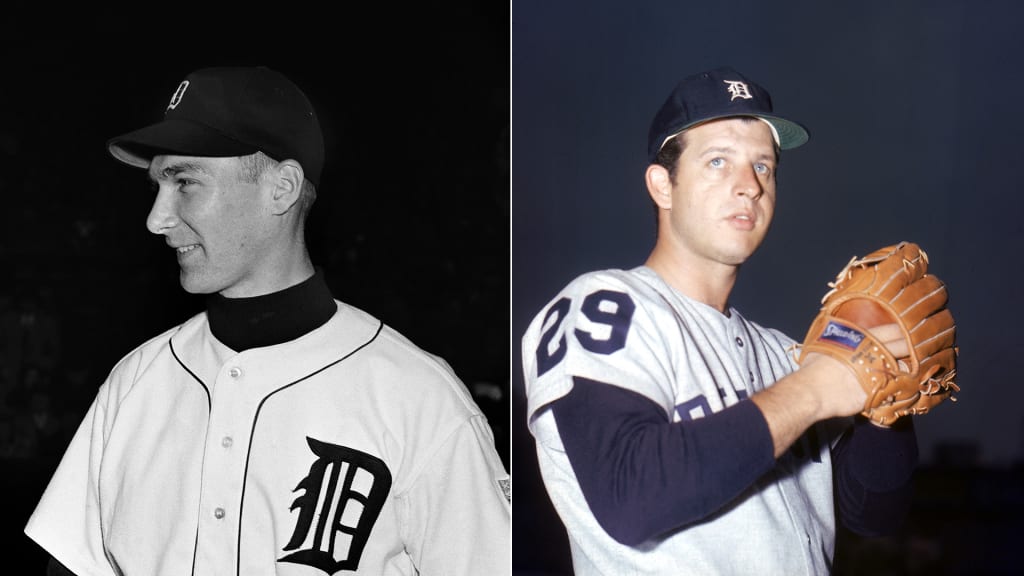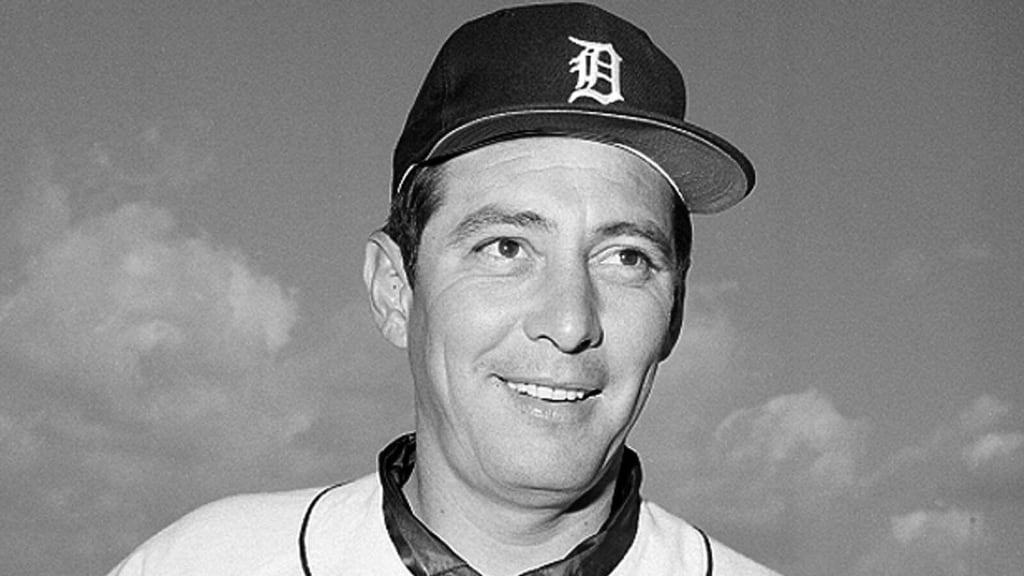
No one loves a good debate quite like baseball fans, and with that in mind, we asked each of our beat reporters to rank the top five players by position in the history of their franchise, based on their career while playing for that club. These rankings are for fun and debate purposes only. If you don’t agree with the order, participate in the Twitter poll to vote for your favorite at this position.
Here is Jason Beck’s ranking of the top five left-handed starters in Tigers history. Next week: Relievers.
1. Hal Newhouser, 1939-53
Key fact: Only Major League pitcher to win back-to-back Most Valuable Player Awards
Long before Denny McLain, Willie Hernandez and Justin Verlander pulled the Cy Young-MVP Award double, Newhouser won back-to-back American League MVP honors in 1944 and ‘45. Just in case anyone attributed his success to having the top hitters away from the game during World War II, Newhouser arguably posted a better season in ‘46, leading the league with 26 wins and a 1.94 ERA while finishing second to Bob Feller in strikeouts. Newhouser would have led AL pitchers in Wins Above Replacement in ‘47 and ’48, too.
It was an amazing Michigan success story. Newhouser was born in Detroit in 1921, the son of first-generation immigrants who moved to the city for work in the automotive industry. He was a hypercompetitive teenager when his hometown Tigers won the World Series in 1935, and he signed with them three years later at age 17. He made his big league debut the following September, won nine games to help the Tigers win the AL pennant in ’40 and became an All-Star in ‘42. He joined the league’s elite pitchers when he unleashed a slider in ‘44.
2. Mickey Lolich, 1963-75
Key fact: 1968 World Series MVP; franchise career leader in starts and strikeouts
In the 1968 Fall Classic, Lolich tossed three complete-game victories, including the deciding Game 7 on two days’ rest to lead the Tigers past the heavily favored Cardinals. But there was plenty more to Lolich’s career than that October -- and more than many would have expected out of a skinny southpaw from Portland who didn’t pick up his trademark belly until the late 1960s. He was a 25-game winner and an AL Cy Young Award runner-up in ‘71, then he put up 22 more wins the next season to lead the Tigers back to the postseason. Lolich earned three All-Star selections from 1969-72.
Lolich’s 2,679 career strikeouts not only stand as a franchise record, they were the most by any left-hander in AL history until CC Sabathia passed him in 2017. His 207 wins and 3,361 2/3 innings as a Tiger rank third in franchise history behind Hooks Dauss and George Mullin. He ranks in the top 100 all time among Major League pitchers in strikeouts (20th), shutouts (41st), wins (84th), losses (52nd), innings pitched (59th) and walks (77th).
3. Ed Killian, 1903-10
Key fact: Won both games of a doubleheader to clinch the 1909 AL pennant
After those two, there’s a drop-off to the rest of the Tigers lefty starters. But Twilight Ed Killian -- nicknamed for how many long games he pitched through the afternoon and into early evening -- was a key pitcher during Detroit’s successful first decade of play. His 23 wins in 1905 included a league-leading eight shutouts. He won 25 games on the ‘07 team that earned the first of the Tigers’ three consecutive World Series berths. He tossed a combined 16 innings in a doubleheader sweep on the final day of the regular season in ‘09, earning Detroit its third straight pennant. All that eluded Killian was postseason success; he made a long relief appearance in the 1907 World Series, was roughed up by the Cubs in Game 1 in ‘08 and was left out of the ‘09 Series entirely.
Even for the dead-ball era, Killian’s ability to limit home runs was noteworthy. He went almost four full years without allowing a homer after giving up one during his rookie season, including three homerless seasons and nearly 800 homerless innings from 1904-06.
4. Hank Aguirre, 1958-67
Key fact: Led AL pitchers with a 2.21 ERA in 1962
Though Aguirre made more relief appearances than starts in his 10-year Tigers tenure, his greatest years by far came primarily as a starter. After four seasons in Detroit’s bullpen, Aguirre made a spot start at Yankee Stadium on Memorial Day weekend in place of Phil Regan and pitched a five-hitter in a 2-1 win. Two weeks later, he made another spot start and went eight quality innings with six strikeouts. After beating the Yankees again, he tossed a three-hit shutout with 11 strikeouts in Baltimore at the end of June, starting a string of three consecutive complete games.
Though Aguirre bounced back and forth all season, he had tallied enough innings to qualify for the ERA title, and his 2.21 clip beat out Baltimore’s Robin Roberts by better than half a run. His 7.4 bWAR was nearly two full wins better than the next-best AL pitcher that year. He also made his lone All-Star appearance.

5. Kenny Rogers, 2006-08
Key fact: Tossed 23 scoreless innings over three victories in the 2006 postseason
What Pudge Rodriguez meant for the Tigers in their revival from 119 losses in 2003 to the World Series three years later, Rogers arguably meant for their pitching staff. A year after Detroit missed out on Carl Pavano, the club signed a 41-year-old Rogers on the recommendation of veteran scout Dick Egan. Coming off back-to-back All-Star seasons but a controversial run-in with a Texas cameraman, Rogers not only tied a career high with 17 wins but provided leadership for an otherwise young pitching staff. He then lifted the Tigers on their postseason run, tossing 7 2/3 scoreless innings in Game 3 of the AL Division Series against the Yankees, another 7 1/3 scoreless innings in Oakland in Game 3 of the ALCS and eight scoreless frames in Game 2 of the World Series.
Honorable mentions
Frank Tanana finished just above .500 with an average ERA in his Tigers tenure, but the Detroit-born lefty will always be known for the shutout he threw against the Blue Jays on the final day of the 1987 regular season to clinch the Tigers’ division title. He outdueled Jimmy Key in a 1-0 victory, completing a three-game stretch in which he allowed one run over 24 innings.
David Price lasted only one year in Detroit, acquired at the 2014 Trade Deadline before being dealt away in ‘15. But he went 13-8 with a 2.90 ERA and 6.4 fWAR in 32 starts for the Tigers, pitching eight strong innings in his lone start in the AL Division Series.
Earl Whitehill never had a particularly great season, but he was pretty good throughout his decade in Detroit. He was a 17-game winner as a rookie in 1924, then generally hovered around .500 for the next eight seasons with an ERA just above average. His 25.0 bWAR ranks fourth all time among Tigers lefties.
David Wells’ Tiger tenure is almost a footnote in his 21-year Major League career, but he was an All-Star in 1995, going 10-3 with a 3.04 ERA in 18 starts for a fourth-place Detroit team. He was a steal for the Tigers, who picked him up after the Blue Jays released him in Spring Training ‘93.
